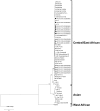Chikungunya infection in India: results of a prospective hospital based multi-centric study
- PMID: 22363413
- PMCID: PMC3281818
- DOI: 10.1371/journal.pone.0030025
Chikungunya infection in India: results of a prospective hospital based multi-centric study
Abstract
Background: Chikungunya (CHIKV) has recently seen a re-emergence in India with high morbidity. However, the epidemiology and disease burden remain largely undetermined. A prospective multi-centric study was conducted to evaluate clinical, epidemiological and virological features of chikugunya infection in patients with acute febrile illness from various geographical regions of India.
Methods and findings: A total of 540 patients with fever of up to 7 days duration were enrolled at Karnataka Institute of Medical Sciences (KIMS), Karnataka (South); Sawai Man Singh Medical College (SMS) Rajasthan (West), and All India Institute of Medical Sciences (AIIMS) New Delhi (North) from June 2008 to May 2009. Serum specimens were screened for chikungunya infection concurrently through RT-PCR and serology (IgM). Phylogenetic analysis was performed using Bioedit and Mega2 programs. Chikungunya infection was detected in 25.37% patients by RT-PCR and/or IgM-ELISA. Highest cases were detected in south (49.36%) followed by west (16.28%) and north (0.56%) India. A difference in proportion of positives by RT-PCR/ELISA with regard to duration of fever was observed (p<0.05). Rashes, joint pain/swelling, abdominal pain and vomiting was frequently observed among chikungunya confirmed cases (p<0.05). Adults were affected more than children. Anti-CHIK antibodies (IgM) were detected for more than 60 days of fever onset. Phylogenetic analysis based on E1 gene from KIMS patients (n = 15) revealed ∼99% homology clustering with Central/East African genotype. An amino acid change from lysine to glutamine at position 132 of E1 gene was frequently observed among strains infecting children.
Conclusions: The study documented re-emergence of chikungunya in high frequencies and severe morbidity in south and west India but rare in north. The study emphasizes the need for continuous surveillance for disease burden using multiple diagnostic tests and also warrants the need for an appropriate molecular diagnostic for early detection of chikungunya virus.
Conflict of interest statement
Figures



References
-
- Peters CJ, Dalrymple JM, Alphaviruses . In: Fields virology. 2nd ed. Vol 1. Fields BN, Knipe DM, Chanok RM, et al., editors. New York: Raven Press; 1990. pp. 713–61.
-
- Schwartz O, Albert ML. Biology and Pathogenesis of Chikungunya virus. Nat Rev Microbiol. 2010;8:491–500. - PubMed
-
- Staples JE, Breiman RF, Powers MA. Chikungunya fever: An epidemiological review of a re-emerging infectious disease. Clin Infect Dis. 2009;49:942–8. - PubMed
-
- Rao TR, Anderson CR. Concluding review on the papers on the outbreak of febrile illness with hemorrhagic manifestations in Calcutta. Indian J Med Res. 1964;52:727–34. - PubMed
-
- Powers AM, Logue CH. Changing patterns of chikungunya virus: Re-emergence of a zoonotic arbovirus. J Gen Virol. 2007;88:2363–77. - PubMed
Publication types
MeSH terms
Substances
LinkOut - more resources
Full Text Sources
Medical

